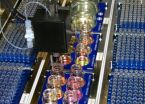(Press-News.org) The world population is estimated to be seven billion and all these mouths need feeding. With fears about overfishing and the sustainability of fish stocks in our seas fish farming is becoming big business. As with all farming there are issues about maintaining the health of stock and how to prevent bacterial infection. New research published in BioMed Central's open access journal BMC Microbiology demonstrates that a prototype water purification reactor containing a thin film of titanium dioxide (TiO2) is able to enhance the sun's natural disinfection properties This device could reduce the need for expensive antibiotics or poisonous chemicals.
Outbreaks of infectious diseases by bacteria and other microbial pathogens can cause substantial losses of stock in aquaculture. While antibiotics, biocides and conventional disinfectants can be used, they are expensive and leave behind chemical residues. Using sunlight for disinfection is not a new idea however conventional solar disinfection is slow and inefficient.
Researchers from CQUniversity, Australia, addressed this problem by adapting thin-film fixed-bed reactor (TTFBR) technology to provide treated water. In the reactor water contaminated by Aeromonas hydrophila was slowly passed over a sloping film of TiO2 at a fixed rate and in full sunlight. Results showed that using TiO2 as a photocatalyst increased the effectiveness of solar disinfection by over 10 times.
Prof Rob Reed, one of the team who performed this work explained, "Other people have looked at using TiO2 as an enhancer of solar disinfection, but they either used a suspension of TiO2 particles in water, or artificial UV to test their reactors. Our TTFBR technology is very effective at killing pathogens at high levels of natural sunlight and consequently is particularly suited to countries with sunny climates and is especially useful to developing countries where sunlight is abundant but other resources are scarce."
###
Notes to Editors
1. Thin-film fixed-bed reactor (TFFBR) for solar photocatalytic inactivation of aquaculture pathogen Aeromonas hydrophila
Sadia J Khan, Robert H Reed and Mohammad G Rasul
BMC Microbiology (in press)
Please name the journal in any story you write. If you are writing for the web, please link to the article. All articles are available free of charge, according to BioMed Central's open access policy.
Article citation and URL available on request at press@biomedcentral.com on the day of publication.
2. BMC Microbiology is an open access, peer-reviewed journal that considers articles on analytical and functional studies of prokaryotic and eukaryotic microorganisms, viruses and small parasites, as well as host and therapeutic responses to them and their interaction with the environment.
3. BioMed Central (http://www.biomedcentral.com/) is an STM (Science, Technology and Medicine) publisher which has pioneered the open access publishing model. All peer-reviewed research articles published by BioMed Central are made immediately and freely accessible online, and are licensed to allow redistribution and reuse. BioMed Central is part of Springer Science+Business Media, a leading global publisher in the STM sector.
END
Furring of the arteries, atherosclerosis, is a leading cause of death across the world. Atherosclerosis leads to peripheral arterial disease, coronary heart disease, stroke and heart attacks. However, atherosclerosis is a sneaky killer - most people do not realize they have it until they have cardiovascular disease (CV). New research published in BioMed Central's open access journal BMC Medical Genomics has identified a set of biomarkers which can be used to test for early stage atherosclerosis.
Researchers from the University of Virginia compared biomarkers isolated ...
A team of geneticists and computational biologists in the UK today reveal how an ancient mechanism is involved in gene control and continues to drive genome evolution. The new study is published in the journal Cell.
To function properly, mammalian tissues require the protein CTCF, which has several key activities including the regulation of genes and interaction with proteins in the cell's nucleus to alter gene activity. CTCF acts by binding to DNA and plays a role in diseases such as HIV infection and cancer. However, very little is known about the origin of the DNA sequences ...
Investigators in the Massachusetts General Hospital (MGH) Center for Systems Biology have discovered a previously unknown type of immune cell, a B cell that can produce the important growth factor GM-CSF, which stimulates many other immune cells. They also found that these novel cells may help protect against the overwhelming, life-threatening immune reaction known as sepsis.
"B cells are a family of white blood cells that secrete antibodies, and GM-CSF induces the production or activation of granulocytes and macrophages, other white blood cells that have specific ...
DURHAM, N.C. -- While physicists at the Large Hadron Collider smash together thousands of protons and other particles to see what matter is made of, they're never going to hurl electrons at each other. No matter how high the energy, the little negative particles won't break apart. But that doesn't mean they are indestructible.
Using several massive supercomputers, a team of physicists has split a simulated electron perfectly in half. The results, which were published in the Jan. 13 issue of Science, are another example of how tabletop experiments on ultra-cold atoms and ...
More than half of all cases of dementia in the elderly can be attributed to Alzheimer's disease. Despite vast research efforts, an effective therapy has not been developed, and treatment consists of dealing with the symptoms. Changes in brain tissues are a hallmark of Alzheimer's. In affected individuals, small protein fragments known as amyloid beta peptides accumulate and are deposited in the gray brain matter. Researchers recently identified a series of synthetic compounds (inhibitors) that interfere with the self-assembly of the amyloid beta peptide in vitro; they influence ...
PASADENA, Calif.—Astronomers from the California Institute of Technology (Caltech) and the University of Arizona have released the largest data set ever collected that documents the brightening and dimming of stars and other celestial objects—two hundred million in total.
The night sky is filled with objects like asteroids that dash across the sky and others—like exploding stars and variable stars—that flash, dim, and brighten. Studying such phenomena can help astronomers better understand the evolution of stars, massive black holes in the centers of galaxies, and the ...
PASADENA, Calif. -- A team of researchers at the California Institute of Technology (Caltech) has devised a new method for making complex molecules. The reaction they have come up with should enable chemists to synthesize new varieties of a whole subclass of organic compounds called nitrogen-containing heterocycles, thus opening up new avenues for the development of novel pharmaceuticals and natural products ranging from chemotherapeutic compounds to bioactive plant materials such as morphine.
The team—led by Brian Stoltz, the Ethel Wilson Bowles and Robert Bowles Professor ...
SAN DIEGO – (January 12, 2012) Researchers at the La Jolla Institute for Allergy & Immunology have proven – for the first time in human tissues -- the specific immune system T cells which trigger the destruction of type 1 diabetes in the pancreas. The finding is an important advance that verifies in humans several important disease characteristics shown in mouse studies and provides a key focal point for interrupting the disease process.
"This study marks the first time that the presence of beta cell-reactive T cells has been directly proven in pancreas tissues from ...
EVANSTON, Ill. --- By putting 18 million cracks in the proverbial glass ceiling, Hillary Clinton changed the way Americans think about women in politics, and new Northwestern University research suggests that an affirmative action law in India is doing the same for Indian women.
The research, to be published Jan. 12 in the journal Science, focused on the long-term outcomes of a law that reserved leadership positions for women in randomly selected village councils in India.
The law has led to a direct role model effect and is changing the way the girls as well as their ...
No less than one third of a car's fuel consumption is spent in overcoming friction, and this friction loss has a direct impact on both fuel consumption and emissions. However, new technology can reduce friction by anything from 10% to 80% in various components of a car, according to a joint study by VTT Technical Research Centre of Finland and Argonne National Laboratory (ANL) in USA. It should thus be possible to reduce car's fuel consumption and emissions by 18% within the next 5 to 10 years and up to 61% within 15 to 25 years.
There are 612 million cars in the world ...


